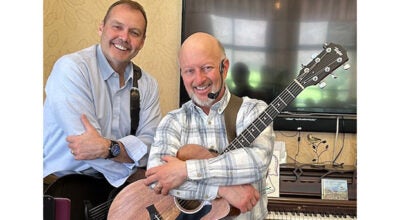Living with Parkinson’s: Dowagiac woman copes with disease
Published 8:00 am Wednesday, April 9, 2014
The biggest element that has been removed from the life of Donna Korzun since she was diagnosed with Parkinson’s Disease has been spontaneity, the ability to just go outside and do whatever she wants.
“On Saturday, I went and saw a movie at the theater,” the Dowagiac resident said. “That’s a rare occurrence for me these days.”
Trips outside her home, even to stores less than mile away, must be planned out in advance. Even then, she’s had to reconsider such engagements due to complications flaring up before departing.
“I can’t tell until I get up what kind of day I’m going to have,” she said.
Korzun, 58, is one of 1 million Americans living with the disease, which causes the death of dopamine-generating cells in the nervous system, resulting in problems to the person’s motor functions. With April being the Parkinson Disease Foundation’s awareness month, Korzun is looking to do her part to spread knowledge about the condition.
Korzun, who is married to Southwestern Michigan College’s Band Director Jonathan Korzun, has lived in Dowagiac for 18 years. She had spent the last decade and a half working as an occupational theory assistant after graduating from Lake Michigan College in 1996.
Working at various nursing homes and medical care facilities in the region, Korzun had prior experience in caring for patients with Parkinson’s and other medical conditions, teaching them how to continue caring for themselves. Her first-hand knowledge of the disease’s effects has been both a benefit and a hindrance in dealing with her condition, Korzun said.
“It changes your way of thinking,” Korzun said. “It’s called putting on your therapy glasses. You change your mindset, like you’re playing chess. On the other hand, it makes you more afraid of what may come next, since you’ve already seen it in others.”
Korzun began to experience symptoms of the degenerative nervous system disease around 10 years ago, she said. At first, she noticed that she could no longer walk in a straight line, veering slightly to the right. She also couldn’t close her eyes while standing up without falling over.
“I had to adjust to things to continue caring for patients,” she said.
Around two years ago, her condition began to worsen. Her right arm stopped swinging while she walked, and her pinky began moving on its own.
“When I got the tremors, that’s when things started to click in my head,” she said.
She saw a number of doctors before receiving an official diagnosis that confirmed her worst fears, that she had Parkinson’s.
In addition to giving up her career, the disease also forced Korzun to give up her up interest in music. She had spent most of her life playing the clarinet for various bands and music groups around the region, including helping to start her own group, the Southshore Concert Band.
In addition to medication, Korzun and her husband have made a few adjustments to their home to accommodate her, installing rails on their stairwell, eliminating excess furniture and moving what functions they could to the first floor. Korzun is able to care for herself for the most part, but she occasionally needs help with housework and other tasks, she said.
“Certain things are just too hard, it takes too much of my energy to get done,” she said. “You have to pick and choose your battles.”
However, a number of things have helped her manage her condition, including her Android smartphone, which has voice controls that allow her take photos or search the internet. She has also joined a number of online support groups, she said.
“What helps me is trying to make a difference in others lives,” she said.
Her advice to others who are living with the disease is to reach out to others, to learn how they are coping. While there is no known cure for the condition, with proper medical treatment and support, it’s possible to manage while remaining mostly independent, Korzun said.
“Try not to hide it,” Korzun recommended. “Don’t wallow in it, but don’t hide it either.”
She also recommended that people visit their physician at the first sign of possible symptoms, which include tremors, slowness of movement, muscle stiffness, pain, fatigue, confusion or other cognitive changes.
“Parkinson’s varies from person to person so much,” Korzun said. “You always have the image of an elderly man, hunched over and tremoring. In reality, in 30 percent of reported cases, there are no tremors.”
While only 4 percent of individuals are diagnosed before the age of 50, there are cases of people even below the age of 30 with Parkinson’s, Korzun said.
“It knows no boundaries,” Korzun said. “It doesn’t take any prisoners.”
For more information about the disease, contact the Parkinson’s Disease Foundation at (800) 457-6676 or at info@pdf.org.







